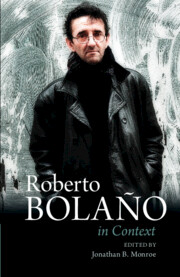Book contents
- Roberto Bolaño in Context
- Roberto Bolaño in Context
- Copyright page
- Contents
- Contributors
- Chronology
- Part I Geographical, Social, and Historical Contexts
- Part II Shaping Events and Literary History
- Part III Genres, Discourses, Media
- Chapter 16 Essays and Short Stories
- Chapter 17 Poetry I: The Ghost That Runs through the Writing
- Chapter 18 Poetry II: Parody and the Question of History
- Chapter 19 The Novel and the Canon
- Chapter 20 Detective Fiction
- Chapter 21 Journalism, Media, Mass Culture
- Chapter 22 Literary Criticism and Literary History
- Part IV Aesthetics, Culture, and Politics
- Further Reading
- Index
Chapter 19 - The Novel and the Canon
from Part III - Genres, Discourses, Media
Published online by Cambridge University Press: 15 December 2022
- Roberto Bolaño in Context
- Roberto Bolaño in Context
- Copyright page
- Contents
- Contributors
- Chronology
- Part I Geographical, Social, and Historical Contexts
- Part II Shaping Events and Literary History
- Part III Genres, Discourses, Media
- Chapter 16 Essays and Short Stories
- Chapter 17 Poetry I: The Ghost That Runs through the Writing
- Chapter 18 Poetry II: Parody and the Question of History
- Chapter 19 The Novel and the Canon
- Chapter 20 Detective Fiction
- Chapter 21 Journalism, Media, Mass Culture
- Chapter 22 Literary Criticism and Literary History
- Part IV Aesthetics, Culture, and Politics
- Further Reading
- Index
Summary
Roberto Bolaño was the only Latin American novelist of the post-Boom period who attained notoriety similar to that of his famous predecessors. Exploring what makes his brief Nocturno de Chiles worthy of such canonical status, I propose five criteria of evaluation: 1) elevated themes, as put forth by Longinus; 2) a self-reflexive literary warp; 3) an unfathomable secret; 4) transformation of received tradition; and 5) a style at once profound, unique, and recognizable. The confession of a priest, Sebastián, presumably on his death bed, the novel recounts his life, including his concomitant vocations for the priesthood and literature. Longinian elevation is manifest comically. The protagonist’s immersion in both the classical and the modern provides literariness. The secret resides in the presence of an Austrian shoemaker whose monument to national heroes seems to point to the origins of fascism. Sebastián’s consideration of current Chilean writers and their knowledge of universal works, such as the Divine Comedy becomes a consideration of literary tradition. And his elegant, erudite style is evident from the very beginning. In the end he and the reader realize that the “wizened youth” who challenges him as his conscience throughout is the one writing the novel.
- Type
- Chapter
- Information
- Roberto Bolaño In Context , pp. 212 - 223Publisher: Cambridge University PressPrint publication year: 2023

